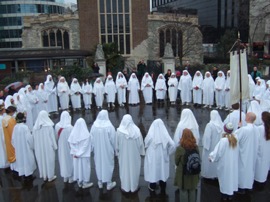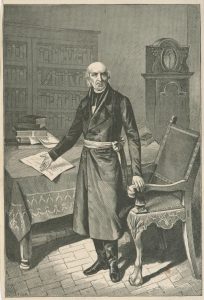More than likely when you hear the word Druid, you conjure up an image of an old man with a beard dressed in robes dancing among trees. However, this modern idea of Druids is not as accurate as one might think. Some common misconceptions of the Druid practice are that the Druids worshipped trees, engaged in frequent human sacrifice, and are no longer around today. However, all of these ideas are myths.1 Nonetheless, the modern Druids still maintain many of same practices and ideologies that the old society created, but they no longer hold the same status or power of the past.

The original Druid culture flourished around the same time as Julius Caesar. Because there was no written history of the Druids before this time, it is hard to know their exact origin. Luckily, during this time period their roles in society were well-marked. There were three different groups of peoples that would later be conflated into the category of Druids. These groups were the Bards, singers and poets of the Celtic Iron Age; the Vates, priests and scholars of nature; and finally the Druids, studiers of nature and the judges and judiciaries of the ancient tribes. As time marched on and vague documentation of the Vates, Bards, and Druids continued, the Druid practices would be confused with those belonging to the Bards and Vates. This was most likely due to the Druids’ having a hand in every part of peoples’ lives. In today’s religious systems, we see the union between the Vates and the Druids as these contemporary Druids believe in the unity of nature and the universe.2

In the ancient society, each branch had their own role to play among the people in the area. From about 50 B.C. to 450 A.D., most information about the Druids was recorded near Gaul. Gaul was an ancient land comprised of modern day France, Luxembourg, Belgium, as well as parts of Switzerland, Northern Italy, the Netherlands, and Germany. The Gaulish people were comprised of several tribes that were constantly at war. In this society, tribes used Vates, or Vatis (singular), to host funerals and ceremonies to bless the people, while Druids were looked up to and held to a much higher standard. It is said that a Druid Priest could walk between two warring tribes and each side would lay down their arms out of respect.3 Of course the Druids were not restricted to Gaul, and Caesar often noted in his writings that the Druid peoples mostly held Britain as the “heartland of the Druid tradition.”4 For this specific work, I will focus on Gaulish tradition, though many Druids today live in Ireland. It was in Britain where the Druids were recently officially recognized as a religion.5

Much like the Vates, Druids were students of Nature, only on a much broader scale. The Druids believed that there was a balance to everything, and that it was necessary to maintain it, a key feature that the contemporary Druids have made sure to maintain. We can see a difference between the two groups in reference to the ancient judicial system. Druids were scholars but also judiciaries of the society and would often convict criminals of their crimes. Although murder was not acceptable, the Gaulish people believed that if a criminal was sacrificed, the land would prosper. Therefore, since the Druids oversaw who was convicted with what charge, it often fell to the Druids to decide who would be sacrificed. Of course, this is not to say that the sacrifices were inherently savage; the Vates performed sacrifices in accordance with tradition, and the Druids always oversaw the Vates’ sacrifices as a form of law enforcement.6 Once these sacrifices were completed, the Vates would interpret the results, and so they were often referred to as “prophets” as they informed tribes of their futures and what needed to be done to remedy problems. These rituals were mostly performed once every five years as a part of a harvest festival. In this manner, the balance of good and evil was restored, and peace and good tidings settled among the people.7

Because these three groups were so prestigious, the knowledge and teachings of each group were often kept secret. For Druids, they learned often through memorizing oral recitations. Because of this form of learning, the failure rate amongst Druid scholars was high. Think of it like going to law school for 20 years, but nothing is ever written down. Nonetheless, by keeping all information recorded through verbalized teaching, it kept the Druids apart from society. For more than twenty years, a pupil learned the ways of a Druid, studying the immortality of the soul and the doctrine of reincarnation, the motion of the stars and the size of the earth and universe. They memorized the power of the gods as well as studying nature in order to explain natural phenomena and the universe’s behavior. The current Druid culture still studies nature, but the need for law is no longer in their hands, and so the modern religion no longer needs 20 years of teachings.8
In today’s society, the common misperceptions that Druids live in the woods and sing to birds are inadequate. Today, Druids remain present as a religious group as well as a cultural movement for those who do not want to be official members. Contemporary Druids follow the old teachings of harmony and connection to the natural world.9 Much like the Iron Age Druids, they also often believe in Reincarnation. Unfortunately since the Celtic Druids relied on oral teachings, not much is known about the original class of Druids, leaving much room for interpretation amongst current groups. Not only is this present religion often used as a source of reassurance for the old practices, but modern Druids provide a plethora of new knowledge regarding the peoples.10 Not only is the religion a fantastic source for a re-emergence of romanticism and spiritual connectivity, but today’s Druids tend to hold nature highly and worship in the outdoors. They also still believe in reincarnation, therefore providing another religion for those who believe in the cycle of nature the opportunity to practice.11
Of course, just because the modern Druids and ancient Druids share religious beliefs, does not mean everything about the two groups is the same. The world has changed and new customs and laws have been brought about, and so the hierarchy of the Celtic Druids has had to adapt. In today’s society, over 10,000 peoples identify as Druids, but yet this is not to say that 10,000 people hold the ability to walk between two warring nations and have them lay down their arms. Unlike the past, all respect for the Druid culture as an ancient judiciary branch has been lost with the development of various independent nations and court systems.12 Because of changing societal roles and the separations of religious groups and governments, the Druids now remain classified as a religion. In 2010, for example, Britain official recognized Druidry as a religion.13

For many Druids, there is not one set god to whom they need to devote their prayers. Instead, Druids believe in worshipping of spirits and natural powers.14 Often, these powers are found in certain sites, such as Stonehedge, which although it was not created by Druids, it remains one of their holy sites.15 These groups have also respected the original practice that Druids had of electing Chiefs and Councils, now using the term “Senior druid” for the Druid chief, and while some groups do not specify their use of Druid Councils, it is mostly accepted that each denomination possesses one.16
The Druid religion has adapted to societal changes by also giving up the intense secrecy that they once possessed. No longer does the society require twenty years of training, but instead now there is just a fee upon receiving membership.17 Although, in the past, Druids were so secretive that they would only pass on knowledge orally, now the livelihood of the religion may be able to survive into the future by removing this intensive learning commitment from today’s practice. Druids kept their practices orally to keep outsiders from being able to do what they do as the law needed to be maintained and held to a standard, but now that law is not the main role of these Druid practitioners, it is more prosperous to be open to bringing new members. By bringing new members in, the religion could grow and knowledge could be spread. The new society knew that there had to be a change if the religion was to survive. In this way, the new Druids are surviving by openly displaying and discussing the religion, while also respecting their predecessors but keeping rituals and celebrations exclusive to their peoples.18
- Philip Freeman, The Philosopher and the Druids (New York, NY; Simon & Schuster, 2006), 157. ↵
- Stuart Piggot, The Druids (Santa Barbara, CA; Frederick A. Praeger, 1968), 34-57. ↵
- Britannica, 2018, s.v. “Gaul | ancient region, Europe;” Britannica, 2018, s.v. “Druid | Celtic culture.” ↵
- Philip Freeman, The Philosopher and the Druids (New York, NY; Simon & Schuster, 2006), 165. ↵
- A. Glogowska-Balcerzak, M.J. Wasinski “Druids, scientologists and Wiccans – Religious Beliefs and their Manifestation in Strasbourg Jurisprudence,” Study in Humanities, no. 1 (2015), 88. ↵
- Philip Freeman, The Philosopher and the Druids (New York, NY; Simon & Schuster, 2006), 158. ↵
- Philip Freeman, The Philosopher and the Druids (New York, NY; Simon & Schuster, 2006), 159-161. ↵
- Philip Freeman, The Philosopher and the Druids (New York, NY; Simon & Schuster, 2006), 166-168; John Michael Greer, The Druidry Handbook (Weiser books, 2006), 47-59. ↵
- Wikipedia, 2018, s.v. “Druidry (modern).” ↵
- Gregory Elder, “What do we know about the druids and their beliefs?” Redland Daily Facts, August 2017. ↵
- Gregory Elder, “What do we know about the druids and their beliefs?” Redland Daily Facts, August 2017.; Wikipedia, 2018, s.v. “Druidry (modern).” ↵
- “Druidry to be classified as Religion by Charity Commission,” British Broadcasting Company News, October 2010.; Britannica, 2018, s.v. “Druid | Celtic culture.” ↵
- “Druidry to be classified as Religion by Charity Commission,” British Broadcasting Company News, October 2010. ↵
- “Druidry to be classified as Religion by Charity Commission,” British Broadcasting Company News, October 2010. ↵
- Gregory Elder, “What do we know about the druids and their beliefs?” Redland Daily Facts, August 2017. ↵
- “Druidry to be classified as Religion by Charity Commission,” British Broadcasting Company News, October 2010. ↵
- “Druidry to be classified as Religion by Charity Commission,” British Broadcasting Company News, October 2010. ↵
- Philip Freeman, The Philosopher and the Druids (New York, NY; Simon & Schuster, 2006), 166-168; John Michael Greer, The Druidry Handbook (Weiser books, 2006), 47-59; 23. “Druidry to be classified as Religion by Charity Commission,” British Broadcasting Company News, October 2010. ↵



21 comments
Joshua Garza
I found this article to be very appealing to myself. In this article I got the opportunity to learn a lot about yet another culture of people which I had no knowledge of before and I find that very interesting. This is a very well written article and I appreciate the abundance of factual information I have gained after reading this.
Mariah Garcia
The author has done a fantastic job in depicting the lives and culture of the Druids. I found this to be very interesting as I have always heard of Druids in passing but had never known anything concrete about this group. The most interesting thing that I learned from this presented itself in the form of the burning man sacrifice/execution of the Vates. This leads me to question where the traditions of this group originated from.
Ava Rose Rodriguez
This article is really interesting, before reading this I did not really know much about the Druids. It is surprising how they would decide who to sacrifice in the community. The author did a great job informing the readers about how there can be false ideas about who the Druids are. It is interesting to see how they changed a lot of their rules or practices to conform to society as well.
Engelbert Madrid
Every religion is unique and has a special history that remains sacred to them. It’s quite interesting that this religion has no specific events or writings that are sacred to them. Also, I found it interesting that the Druids do not rely on a specific god or gods; instead, they believe in worshiping spirits and natural powers. Furthermore, they would pass on their teachings and knowledge orally, which is a unique tradition of their religion.
Avery Mascorro
I’m surprised at the idea of Druids deciding who is sacrificed in a community. That brings a new, more sinister air about them. Before this article I didn’t even know what druids were at all. Apparently they are assumed to be like plant people who are just innocent member of society that are probably ignored. Then the article paints the picture of a druid walking in to the middle of a battle and everyone stopping out of respect. I think this article helped me find a reverence of early druids.
Danielle Slaughter
This is a very informative article. I’ve always known of the Druids, but I had no idea that there existes the Bards and Vates as well. Something else I found interesting was when you talked about how they studied natural processes in addition to the powers of their gods – I thought of that as akin to science. I do find it hard to take modern Druidism seriously since it is so public, but maybe that is their new way of inviting everyone to try out their religion.
Christopher Hohman
Nice article. I have heard of the Druids before, but I did not know much about them. It sounds like they were quite an interesting religion. It seems that they held a great deal of power among their people in ancient times. It is cool that they would have been able to stop wars merely by making an appearance on the battlefield. That is something no religious leader could accomplish today. Still though their religion has had to adapt to the modern world. And it seems that they have been able to do just that.
Antonio Coffee
This article was very interesting as I have always heard of druids but I never really knew what they were. I was under the impression that they were similar to the shamans of Native American cultures. I thought they handled mainly religious ceremonies and were even rumored to do magic. It was interesting to read that they mainly handled the implications of the law and the study of nature. This is not what I would have expected and it was amazing to learn something new.
Matthew Swaykus
An interesting Article, I must say. I was intrigued by the title alone, but the first paragraph truly hooked my attention. Kristy Feather, the author, did a good job detailing the what we know of history of Druidic culture. She covers the origins of the group along with how their traditions and practices have been either evolved since the height of their influence in the ancient world.
At the same time, I would like to point out the few things included in the article I didn’t like. Not to be harsh, but the last paragraph was somewhat confusing to read and I believe there could have been a better way to conclude the reading.
Gabriel Dossey
This was an interesting article in the practice and history of Druids. When I hear the term I usually think of magic and wonder, however it is interesting to know that they still congregate today. I also find it very interesting that they should gather around Stone Hinge. I think that this article lends itself to inspire readers to do some more research.